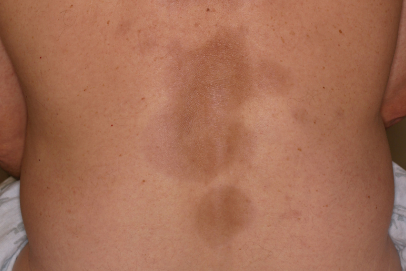Idiopathic atrophoderma of Pasini and Pierini is a superficial large-patchy skin atrophy with hyperpigmentation. ICD-10 code: L90.3
Etiology and pathogenesis are not fully understood. It occurs more frequently in females during adolescence or young adulthood. Family cases have been described, including the combination of localized scleroderma and atrophoderma of Pasini and Pierini in twins, but the genetic nature of the disease has not been established.
Some authors consider atrophoderma to be a form of morphea in which atrophy is more pronounced than sclerosis. The zosteriform distribution suggests a possible neurogenic origin, while the presence of antinuclear antibodies suggests an immunogenic origin. No association with the HLA system has been found.Typically, there are a few large, superficial, slightly depressed patches of atrophy with visible vessels along the spine and trunk. These patches have round or oval borders and appear brown or purplish red. Hyperpigmentation is characteristic. Skin surrounding the lesions is unaffected.
There may be disseminated small patchy lesions localized on the trunk and proximal areas of the limbs. There is usually no induration at the base and no inflammatory or purpuric margin at the periphery.
There are no subjective complaints. This disease is chronic and progressive. New lesions may appear along with the enlargement of old ones. Spontaneous resolution is possible.The diagnosis is made based on the presence of hyperpigmented superficial atrophic patches.
Histopathology reveals early-stage dermal edema, small inflammatory infiltrates of lymphocytes and histiocytes around dilated vessels, and thinning of the epidermis, decreased elastic fibers, and homogenization of collagen fibers.- Morphea
- Anetoderma
- Postinflammatory hyperpigmentation
Disease stabilization can occur even without treatment. In the early stage, penicillin can be prescribed at a dose of 1,000,000 IU per day for 2-3 weeks.(Not evidence based. Need more investigations)
PUVA or UVA therapy are also possible.
